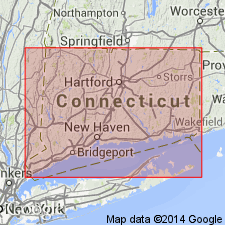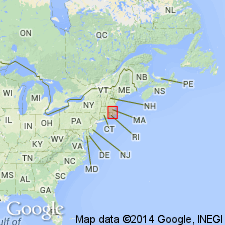
- Usage in publication:
-
- Canterbury granite gneiss
- Modifications:
-
- Original reference
- Dominant lithology:
-
- Gneiss
- AAPG geologic province:
-
- New England province
Summary:
Pg. 115, 136, 142, and map. Canterbury granite gneiss. Essentially a muscovite-biotite gneiss, varying from a rock of fine and even grain to one of porphyritic texture with feldspar crystals a quarter of an inch long. Present in eastern Connecticut and southern Massachusetts. Extends for 15 miles through Pomfret, Brooklyn, Hampton, and Canterbury, and smaller detached areas occur in neighboring towns. Is intrusive. Age is Late Carboniferous or post-Carboniferous(?).
Probably named for town of Canterbury, Windham Co., eastern CT.
Source: US geologic names lexicon (USGS Bull. 896, p. 336); supplemental information from GNU records (USGS DDS-6; Reston GNULEX).

- Usage in publication:
-
- Canterbury Gneiss*
- Modifications:
-
- Age modified
- Geochronologic dating
- AAPG geologic province:
-
- New England province
Summary:
Dates reported here supercede results of Zartman (1965) because of increased sample size, freshness of samples, and greatly improved technology. Rb-Sr whole-rock isochrons from two samples yielded values of 403+/-28 and 389+/-14 m.y., with a composite age of 392+/-9 m.y. This implies an Early to Middle Devonian age for Canterbury Gneiss.
Source: GNU records (USGS DDS-6; Reston GNULEX).
For more information, please contact Nancy Stamm, Geologic Names Committee Secretary.
Asterisk (*) indicates published by U.S. Geological Survey authors.
"No current usage" (†) implies that a name has been abandoned or has fallen into disuse. Former usage and, if known, replacement name given in parentheses ( ).
Slash (/) indicates name conflicts with nomenclatural guidelines (CSN, 1933; ACSN, 1961, 1970; NACSN, 1983, 2005, 2021). May be explained within brackets ([ ]).

